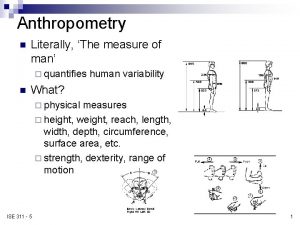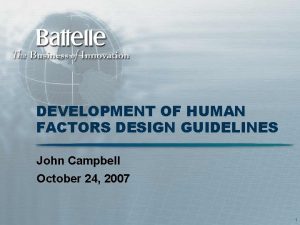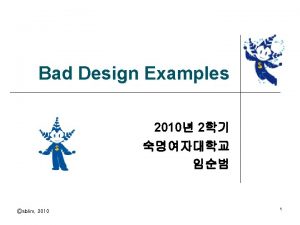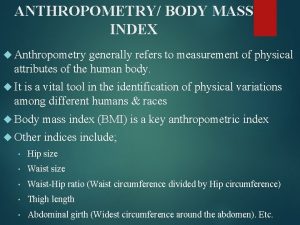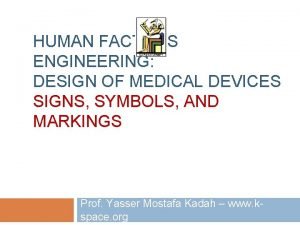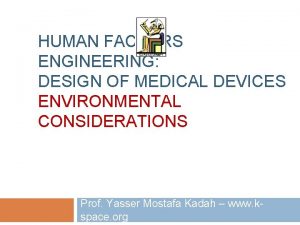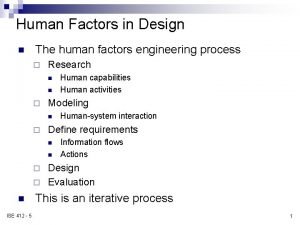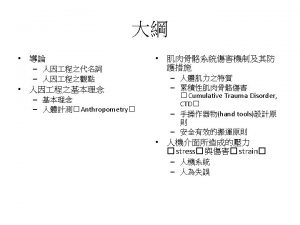HUMAN FACTORS ENGINEERING DESIGN OF MEDICAL DEVICES ANTHROPOMETRY















- Slides: 15

HUMAN FACTORS ENGINEERING: DESIGN OF MEDICAL DEVICES ANTHROPOMETRY AND BIOMECHANICS Prof. Yasser Mostafa Kadah – www. kspace. org

Recommended Reference ANSI/AAMI HE 75: 2009

Anthropometry and Biomechanics Understanding of human physical capabilities and limitations is fundamental to the design of effective medical devices � Properly designed medical devices will help to reduce errors, decrease injury risk, increase productivity, and improve user satisfaction Anthropometry: science of measuring and quantifying various human physical traits (size, weight, proportion, mobility, strength, etc. ) Biomechanics: use of laws of physics and engineering principles to study various body segments as they move and are acted upon by internal and external forces Good anthropometric and biomechanical design principles help designers produce tools, equipment, and workstations that accommodate most of the individuals for whom they are intended

General Considerations Most anthropometric and biomechanical information available today is not specific to health care professionals or patients � Medical device design should account for physical sizes of people � Data on body-size distributions of males and females are available Medical domain has unique anthropometric challenges � Just as useful for medical device designers as designers from other areas Implanted component: no data available In some cases, anthropometric information in the public domain is not detailed enough to be of value

Anthropometric Design Guidance Good anthropometric design of medical devices should accommodate as wide a range of human physical dimensions as is possible � In most cases, design of medical tools, equipment, and workstations ought to accommodate adults ranging in size from a 5 th percentile female to a 95 th percentile male Accommodate larger percentages of the population if: � � � a) the device involves critical functions b) there are safety issues associated with not accommodating extremes c) the user population has large physical diversity d) device usability and functionality is not compromised e) the costs of doing so are not excessive

Available Anthropometric Databases Most anthropometric data have come from military populations � � Existing military data can be considered if it can be assumed that the dimensions of interest are not different for military and civilian populations Kroemer et al. (1997) reported that “with proper caution and insight, we can use military anthropometric data to approximate size data for the general population. Dimensions of the head, hand, and foot are virtually the same in military and civilian populations. ” Database selection should be specific to the population of users of the medical device of interest, if such a database exists � Medical device designers often need even more specific anthropometric data from measurements in specialized

Body Measurement Examples

Body Measurement Examples

Mobility and Functional Measurements Flexibility and mobility Range of motion Functional work Visual Work

Strength Several factors could affect the user’s strength potential � Factors include (but are not limited to) age, gender, health status, body part, body-part position, direction of exertion, whether the exertion is applied statically or dynamically, posture, and environmental issues It is seldom appropriate to expect people to exert their maximum strength, which is what the data reported describe � A common rule of thumb to avoid complaint is to keep the required force below one-third of maximum strength

Special Considerations Gender differences Disabilities Designing for population extremes Designing for the average user Designing for adjustability • Use average anthropometric data only for very general design considerations and never for critical activities or functions • Consider the extremes of the user population (e. g. , allow those on the larger end of the spectrum to “fit” into the space and those on the smaller end of the spectrum to “reach” what is needed) • Whenever possible, allow devices to be adjusted to the user’s size and personal preferences

Derivation of Missing Data Ratio-Scaling technique � Regression Equation technique � Assumes that many individual body sizes (such as various segment lengths) are roughly proportional to each another Assumes a linear relationship between two values. For example, if arm length data exist for 5 th, 50 th, and 95 th percentiles but not for the 1 st and 99 th percentiles, use of regression techniques on the known data could allow the unknown values to be extrapolated Probability Statistics approach � Estimates a measurement for an entire population from data gathered from a small sample.

Biomechanical Design Guidance Body posture � � Endurance � Determine which body part is most relevant to the task, most often used, or most prone to loading or potential injury Focus device design on proper positioning of that joint or body segment Muscular endurance is a function of the amount of strength exerted by a muscle or group of muscles Repetitive motions Repeated use of the same body part to perform a task is known to increase the risk of musculoskeletal injury �

Biomechanical Design Guidance Methods and tools to quantitatively analyze biomechanics � � Expert observation and video Motion analysis EMG Measurement of joint angles and acceleration during movement

Further Reading and Assignments Chapter 7 of Recommended Reference Solved MCQ exams on web site (Part of Medical Equipment courses)
 Engineering anthropometry
Engineering anthropometry Static and dynamic anthropometry
Static and dynamic anthropometry Anthropometry
Anthropometry L
L Static and dynamic anthropometry
Static and dynamic anthropometry Anthropometry
Anthropometry Interior design factors
Interior design factors Human factors design guidelines
Human factors design guidelines Good design and bad design examples
Good design and bad design examples Site vs situation examples
Site vs situation examples Abiotic or biotic
Abiotic or biotic Abiotic vs biotic factors
Abiotic vs biotic factors Abiotic factors and biotic factors
Abiotic factors and biotic factors Biotic and abiotic
Biotic and abiotic Situation vs site factors
Situation vs site factors Gcf of 32 and 12
Gcf of 32 and 12




